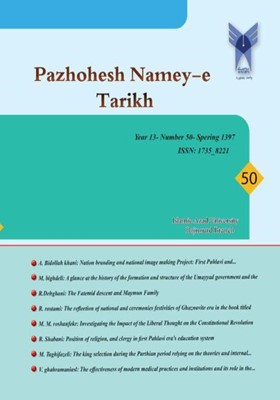-
-
List of Articles
-
Open Access Article
1 - Nation branding and national image making Project: First Pahlavi and reconstruction process of Iran’s image in modern age
Arash Beidollahkhani Yaser Kahrazehi -
Open Access Article
2 - A glance at the history of the formation and structure of the Umayyad government and the causes of its collapse and extinction
Mohsen Bigdeli -
Open Access Article
3 - The Fatemid descent and Maymun Family
BIZHAN Parvan Reza Dehghani -
Open Access Article
4 - The refleetion of national and ceremonies festivities of Ghaznavite era in the book titled 'Tarikhe beihaghi'
rasol rostami farhad parvaneh mojtaba garavand -
Open Access Article
5 - A discussion of the power of Darius and Cyrus killed, Cambiz and Bardia
Ahmad Heydari -
Open Access Article
6 - The position of religion and religion in the educational system of the first Pahlavi period
reza shabani ghobad mansorbakht farshid mehri -
Open Access Article
7 - The king selection during the Parthian period relying on the theories and internal and external, historical Sources
mohamad taghi fazeli farzaneh ahmadi -
Open Access Article
8 - The effectiveness of modern medical practices and institutions and its role in the development of modern medicine in Qajar era
valiulah qahremani asl Mir Asadolah Salehi Panahi Naser Sedqi Shahrzad Sasanpur
-
The rights to this website are owned by the Raimag Press Management System.
Copyright © 2021-2025







